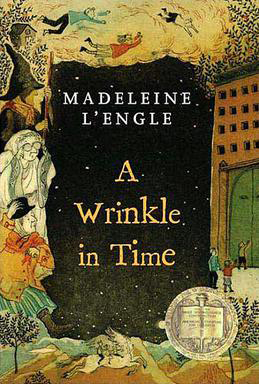
When I was a kid, I read some of the books in this book series out of order. I started with the third book, A Swiftly Tilting Planet, which I loved, followed by A Wrinkle in Time. I recall preferring A Swiftly Tilting Planet more, likely because it had a moonlight-drinking flying unicorn in it (I’ve always loved horses). But after rereading A Wrinkle in Time, I’ve fallen in love once again with Madeline L’Engle’s captivating book series about the Murry family.
A Wrinkle in Time is a heroic science fiction story about siblings Meg and Charles Wallace Murry. Meg is an awkward and plain teenager who finds it hard to fit in at school and to control her temper. Dr. Murry, the children’s father, is a renowned physicist who has been missing for more than two years. When Mrs. Whatsit, a strange old woman, appears at the Murry’s door one dark and stormy night, nothing is ever the same. Soon after, Meg, Charles Wallace, and their new friend Calvin meet Mrs. Whatsit’s housemates, Mrs. Who and Mrs. Which. The mysterious and magical old ladies claim to know the location of Dr. Murry. They use a shortcut to travel through time and space called “tessering” to take the children to their father. Together, they arrive on a different planet that is like Earth, but not. A giant pulsating brain called “IT” controls the mind of all the people on the planet and is keeping Dr. Murry prisoner. Meg finds her father, thinking that he will know how to save them all. But when IT takes control of Charles Wallace’s mind, Meg learns that she—not her father—is the only one who can save her brother and everyone else.
A Wrinkle in Time is a fascinating look at some interesting theories about space and time such as the concept of “tessering,” best explained by two simple illustrations in the book. So is the concept of being able to meet and interact with extraterrestrials, as the children do in the book.
Two interesting themes in the book are good vs. evil and conformity vs. non-conformity. The evil force in the book is the Dark Thing that is steadily taking over the universe. The good forces are the aliens and magical beings that are fighting against the spread of the Dark Thing.
Conformity means that everyone or everything is the same and nonconformity means to be different, or not to conform. On Camazotz, the IT-controlled planet, all the people conform because the IT controls their minds, their decisions, and their actions. The author’s point of view seems to be that conformity is bad and non-conformity is good. Meg’s struggles to fit in at school are a good example. Meg wants to fit in, but does not want to be the same as everyone else. It is kind of like the author is implying that if you conform, you are not thinking for yourself—just like the people of Camazotz.
Reading this book again as an adult actually left me with more questions than it answered. Does the Dark Thing control IT, or is IT the Dark Thing? What exactly is the Dark Thing? I understand why the Dark Thing might want to take over inhabited planets, but why stars? How does Dr. Murry tesser? How come all the aliens speak English? How can the children eat food on other planets without getting sick? How do they breathe on other planets? Are we supposed to assume that all aliens require the same atmosphere to live that humans require on earth?
Perhaps L’Engle’s second book in this series, A Wind in the Door, answers some of these questions. But even with so many unanswered questions, A Wrinkle in Time is a compelling read that I highly recommend to all readers. Overall, I give the book 4 and a half out of 5 stars.



 About BeeLine
About BeeLine